All Articles
What Is the Difference Between a Café and a Restaurant
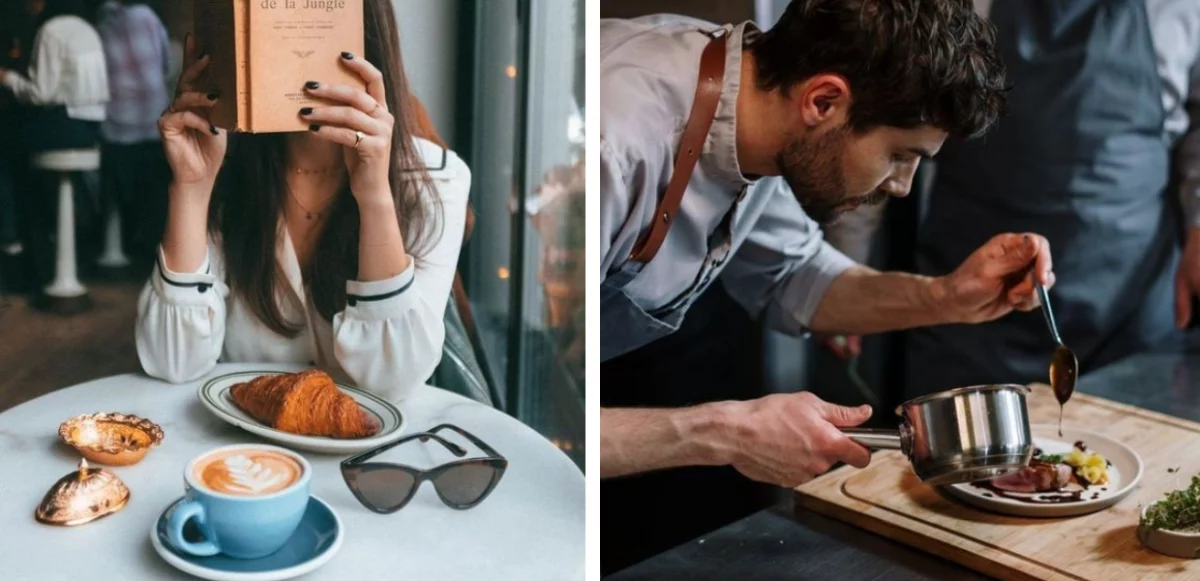
When considering the various types of restaurants, people often wonder if a café is the same as a restaurant. Even entrepreneurs looking to open their venue grapple with this distinction. The differences between cafés and restaurants encompass factors such as ambiance, price, menu, service, operating hours, and more. In this article, I will begin with a brief overview of the origins of these establishments, then explore the factors mentioned above to highlight the key distinctions between a café and a restaurant. I will also point out important considerations for those planning to open a café or a restaurant.
Café Origins
A café is an informal restaurant with a cozy atmosphere that is common in Europe and America. The café’s origins are linked to the Ottoman Empire, with the first opening in Constantinople in 1550. During the 17th century, cafés began to be opened in Italy, France, Germany, and England. The term “café” is borrowed from French and comes from the Turkish “kahve”. All these words refer to the hot drink consumed by most people, namely coffee.
At first, these establishments served only coffee, but not long after, they started serving a small variety of food, such as snacks, cookies, and non-alcoholic drinks. However, from the beginning, they were social hubs where people, usually intellectuals, would meet, converse, play board games, and do other activities.
Restaurant Origins
A restaurant is a place where people can enjoy a wide selection of food and alcoholic or nonalcoholic beverages. It is suitable for special occasions, a unique experience in a luxurious setting, or simply when you want to dine out. The origin of restaurants traces back to 18th-century France, where, in 1765, Chef A. Boulanger opened his business in Paris. He placed a sign above his door advertising “restoratives” or “restaurants,” referring to the soups and broths available inside. Even the English term “restaurant” comes from the French word ‘restaurer,’ which means to restore or refresh.
Café vs. Restaurant: Understanding the Differences
Some differences between a café and a restaurant are visible at a glance, while others require a more detailed analysis to uncover. Here are the key elements that, in my view, best distinguish a café from a restaurant.
Cafés vs. Restaurants Menu
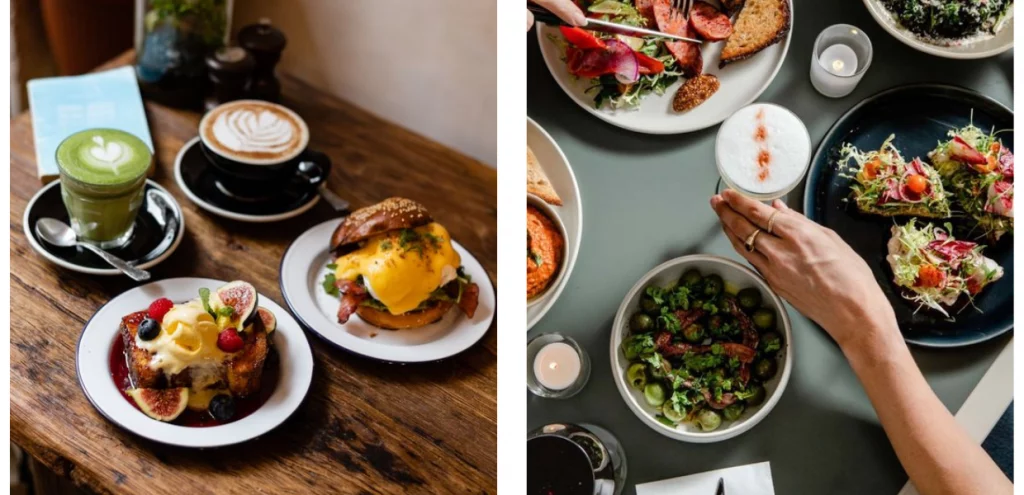
The first and most crucial distinction between the two lies in their menus. A café has a more limited menu than a restaurant. Cafés focus on serving a variety of coffee options, light meals like pastries, sandwiches, salads, and different non-alcoholic beverages such as tea, lemonade, smoothies, sodas, and hot chocolate. They are perfect for a quick bite, informal meetings, or leisurely reading while enjoying a delicious coffee in a cozy atmosphere.
In contrast, restaurants offer a more extensive menu with a vast selection of food and drinks, including alcoholic beverages ranging from classic cocktails to aged spirits. They also serve appetizers, entrees, and desserts. While cafés are ideal for a quick bite, restaurants are usually for those looking for a complete meal. Whether someone is craving a hearty steak or a light salad, restaurants have various options to satisfy their appetite.
Cafés vs. Restaurants Ambiance
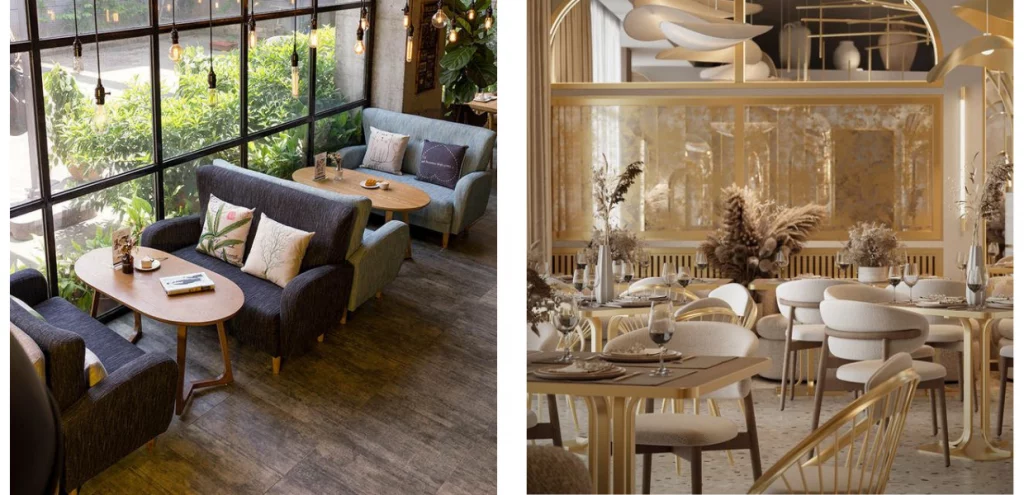
Another distinction lies in the ambiance and design. The café’s atmosphere is warm and inviting, featuring cozy rustic wooden furniture and soothing earthy tones that create the perfect setting for students, hard workers, and introverts alike. Cafés often boast a laid-back vibe with soft background music, comfortable seating options, and an intimate setting. Designed with comfort in mind, they are the ultimate spots for relaxation and rejuvenation. Additionally, many cafés display a variety of artwork, creating an environment where creativity is stimulated.
On the other hand, a restaurant’s atmosphere varies depending on its type. While fast-food restaurants offer a more casual and quick-service environment, fine-dining establishments provide the most formal and upscale experience. Some restaurants may feature an energetic atmosphere with loud music and an active crowd, while others may offer a more relaxed and intimate ambiance with soft lighting and quiet background music. However, it is essential to note that restaurants are generally more formal than cafés and are not designed for relaxation or leisurely activities like reading. They are primarily intended as places to eat.
Cafés vs. Restaurants Building Size
Restaurants and cafés typically differ significantly in terms of the size of their buildings. Restaurants, especially those offering fine dining experiences, often occupy larger spaces to accommodate extensive dining areas, full-service kitchens, and various amenities such as private dining rooms, bars, and sometimes outdoor seating.
In contrast, cafés usually inhabit smaller, cozier spaces, prioritizing a more intimate and relaxed atmosphere. The compact size of a café often contributes to its charm, encouraging social interaction and a sense of community among patrons. This difference in building size reflects the distinct purposes and experiences that restaurants and cafés aim to provide.
Cafés vs. Restaurants Service
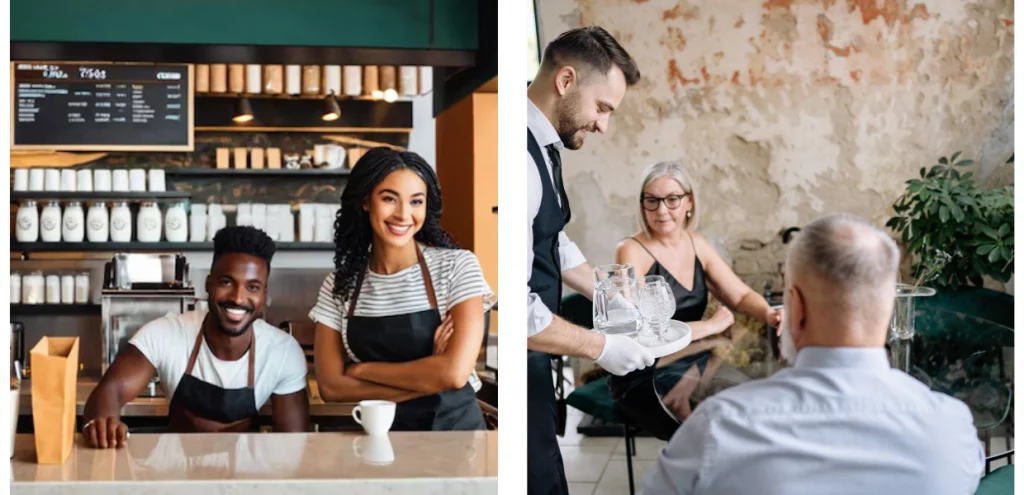
In a café, customers typically place their orders at a counter or bar and then wait for their food or drinks to be prepared. Occasionally, staff may bring the order to the table, but more often, due to the short preparation time, customers collect their orders themselves.
In restaurants, customers are usually seated at a table and presented with menus by the wait staff. The staff takes orders, delivers food and drinks, and checks on diners throughout the meal. However, service styles can vary depending on the type of restaurant. In more casual establishments, there may be self-service or semi-self-service options in addition to traditional waiter service. Semi-self-service allows customers to order and pay at the counter, with the waiter bringing the food to the table once it is ready. In fast-food restaurants, the ordering method is typically self-service, with customers using self-ordering kiosks to place and pay for their orders.
Cafés vs. Restaurants Hours and Meals Covered
Traditionally, cafés open early in the morning and close in the evening. They typically focus on breakfast and lunch items, coffee, and pastries, so they may not stay open as late. However, some cafés, especially those in urban areas or with a more robust evening menu, might remain open later, mainly if they also serve dinner or have a bar.
Restaurants usually have extended hours and often stay open later to cater to diners who prefer to eat dinner after work. They might open for lunch and remain open through the evening, sometimes until 10:00 PM or later. However, this can vary widely; some restaurants might close earlier, mainly if they focus more on lunch or have a specific type of cuisine.
Cafés vs. Restaurants Affordability
Due to differences in their menus, cafés and restaurants vary significantly in terms of affordability. Cafés primarily focus on serving coffee, hot or cold non-alcoholic beverages, and light meals such as pastries and sandwiches, which are generally inexpensive. In contrast, restaurants offer a whole meal experience with a broader range of menu options that can be pretty costly. Therefore, people looking for a light meal and not wanting to spend much money usually choose a café, while those who want a more substantial meal and are willing to pay more would consider a restaurant.
Hybrid Establishments
Over the years, cafés shops and restaurants have undergone significant changes. Initially, cafés served only coffee, but their menus have gradually expanded to include a wider variety of offerings. Similarly, many restaurants have introduced a diverse selection of coffee drinks and have even designed more comfortable spaces to evoke the relaxed atmosphere typical of cafés.
As a result, the lines between cafés and restaurants have blurred, leading to the emergence of a new type of establishment. These hybrid venues, often called gastro-pubs or café-restaurants, combine elements of both to offer a unique dining experience.
A hybrid restaurant offers a blend of the relaxed atmosphere of a café and the formal dining experience found in a restaurant. This establishment is gaining popularity among individuals seeking a distinctive experience that seamlessly bridges the gap between formal and casual dining.
Hybrid establishments combine the most appealing aspects of both cafés and restaurants, catering to diverse tastes and occasions. They typically provide a versatile menu with light snacks, beverages, and more substantial meals and alcoholic drinks. This flexibility makes them an attractive option for many customers, from those looking for a quick coffee break to those wanting a complete dining experience. The rise of hybrid restaurants reflects a growing trend toward more adaptable and customer-centric dining options in the food and beverage industry.
Starting a Café or a Restaurant: What You Should Consider
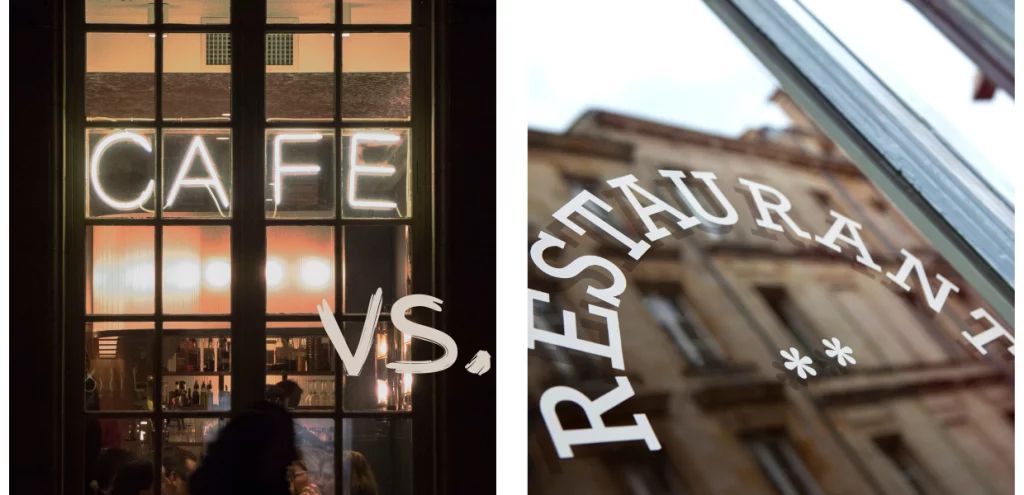
Ultimately, whether to open a café or restaurant is not much of an objective decision. For example, it is not definitively established whether a café is more profitable than a restaurant or vice versa, as many factors such as location, target market, menu pricing, operational costs, competition, and management efficiency influence the profitability of each. So, what should you consider if you are unsure which type of business to open?
- Ask yourself what you want. If you do not already have a preferred type of food business, visit a café and a restaurant and imagine yourself as the owner. Which one is more appealing to you? Your decision is likely already made if you are already drawn to specialty coffees or a particular cuisine.
- It is crucial to ask yourself what you can afford. Opening a café is generally more affordable than opening a restaurant. Cafés typically require a smaller space, a simpler menu, and fewer staff members. Therefore, if your budget is limited and you prefer to avoid large loans, a café might be the best option.
- A third question you must ask is what the demand is in the area in which you want to open your venue. It’s beneficial to address a customer’s needs by providing a solution. If there are no good cafés in the area, why not open one yourself? If there are plenty of cafés, but people want a place to eat, why not open a restaurant?
These three questions are fundamental to help you make a decision about what type of restaurant to open.
Conclusion
As we have seen, several elements differentiate a café from a restaurant, including their menu, building size, service, affordability, ambiance, and hours and meals served. Today, a hybrid of these establishments exists, known as gastro-pubs or café-restaurants. If you’re considering opening either a café or a restaurant, take into account the type of establishment you want to create, your budget, and the demand in your area.
 23 July 2024
23 July 2024 6 min read
6 min read

